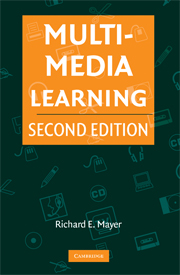Book contents
- Frontmatter
- Contents
- PREFACE
- SECTION I INTRODUCTION TO MULTIMEDIA LEARNING
- 1 The Promise of Multimedia Learning
- 2 The Science of Instruction: Determining What Works in Multimedia Learning
- 3 The Science of Learning: Determining How Multimedia Learning Works
- SECTION II PRINCIPLES FOR REDUCING EXTRANEOUS PROCESSING IN MULTIMEDIA LEARNING
- SECTION III Principles for Managing Essential Processing in Multimedia Learning
- SECTION IV PRINCIPLES FOR FOSTERING GENERATIVE PROCESSING IN MULTIMEDIA LEARNING
- SECTION V CONCLUSION
- REFERENCES
- AUTHOR INDEX
- SUBJECT INDEX
- References
2 - The Science of Instruction: Determining What Works in Multimedia Learning
- Frontmatter
- Contents
- PREFACE
- SECTION I INTRODUCTION TO MULTIMEDIA LEARNING
- 1 The Promise of Multimedia Learning
- 2 The Science of Instruction: Determining What Works in Multimedia Learning
- 3 The Science of Learning: Determining How Multimedia Learning Works
- SECTION II PRINCIPLES FOR REDUCING EXTRANEOUS PROCESSING IN MULTIMEDIA LEARNING
- SECTION III Principles for Managing Essential Processing in Multimedia Learning
- SECTION IV PRINCIPLES FOR FOSTERING GENERATIVE PROCESSING IN MULTIMEDIA LEARNING
- SECTION V CONCLUSION
- REFERENCES
- AUTHOR INDEX
- SUBJECT INDEX
- References
Summary
The science of instruction is concerned with evidence-based principles for how to help people learn. Evidence-based practice occurs when instructional practice is based on research evidence. A multimedia instructional message is a communication using words and pictures that are intended to promote learning. In our research, examples of multimedia instructional messages include paper-based printed text and illustrations or computer-based narration and animation that explain how lightning storms develop, how car braking systems work, and how bicycle tire pumps work; and interactive computer simulation games that teach topics such as environmental science. In our research, learning outcomes are assessed with transfer tests that provide a quantitative measure of the learner's ability to use what was learned in new situations. An instructional method is a way of presenting a lesson. Overall, we examine the effectiveness of twelve instructional methods for promoting multimedia learning – coherence, signaling, redundancy, spatial contiguity, temporal contiguity, segmenting, pre-training, modality, multimedia, personalization, voice, and image. Our methodology involves conducting scores of experimental comparisons in which we compare the mean transfer test score of students who learned with an instructional feature to the performance of students who learned without the feature. To standardize the comparisons, we compute the effect size. Obtaining large effect sizes across a series of experimental comparisons helps determine what works in multimedia instruction.
Information
- Type
- Chapter
- Information
- Multimedia Learning , pp. 28 - 56Publisher: Cambridge University PressPrint publication year: 2009
References
Accessibility standard: Unknown
- 3
- Cited by
